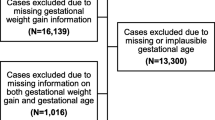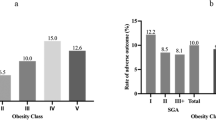Abstract
Objective Limited data are available that estimate the effect of gestational weight gain on maternal and neonatal outcomes in underweight women according to revised 2009 Institute of Medicine (IOM) guidelines. Methods A population-based historical cohort study of 21,674 underweight women in Missouri delivering liveborn, singleton, term infants in 2002–2008 was conducted. Adjusted odds ratios were calculated for gestational weight gain categories with multiple logistic regression, using the 2009 IOM recommended 28–40 pounds as the reference group. Results Women gaining >40 pounds compared to women gaining 28–40 pounds had significantly higher odds for preeclampsia (aOR 1.94, 95% CI 1.56–2.42, p < 0.001), cesarean delivery (aOR 1.40, 95% CI 1.28–1.53, p < 0.001), large-for-gestational-age (LGA) infant (aOR 2.32, 95% CI 2.00–2.70, p < 0.001), and 1 min APGAR score <4 (aOR 1.36, 95% CI 1.01–1.83, p < 0.05) and significantly lower odds for small-for-gestational-age (SGA) infant (aOR 0.53, 95% CI 0.48–0.59, p < 0.001). Women gaining <28 pounds compared to women gaining 28–40 pounds had significantly higher odds for SGA infant (aOR 1.85, 95% CI 1.69–2.03, p < 0.001) and significantly lower odds for preeclampsia (aOR 0.72, 95% CI 0.53–0.96, p < 0.05) and LGA infant (aOR 0.50, 95% CI 0.39–0.63, p < 0.001). Conclusion Women gaining more than the IOM recommendation were at higher risk for many adverse outcomes, but at lower risk for SGA infants. Women gaining less than the IOM recommendation were at higher risk for SGA infants but were protective for preeclampsia and LGA infants. Prospective studies of other short- and long-term maternal/infant outcomes are needed to evaluate the efficacy of the IOM guideline.
Similar content being viewed by others
Abbreviations
- BMI:
-
Body mass index
- CI:
-
Confidence interval
- IOM:
-
Institute of Medicine
- LGA:
-
Large-for-gestational-age
- OR:
-
Odds ratio
- SGA:
-
Small-for-gestational-age
References
Albertsson-Wikland, K., & Karlberg, J. (1997). Postnatal growth of children born small for gestational age. Acta Paediatrica, 423, 193–195.
Alexander, G. R., Himes, J. H., Kaufman, R. B., Mor, J., & Kogan, M. (1996). A United States national reference for fetal growth. Obstetrics and Gynecology, 87(2), 163–168.
Araz, N., & Araz, M. (2006). Frequency of neonatal hypoglycemia in large for gestational age infants of non-diabetic mothers in a community maternity hospital. Acta Medica, 49(4), 237–239.
Boney, C. M., Verma, A., Tucker, R., & Vohr, B. R. (2005). Metabolic syndrome in childhood: Association with birth weight, maternal obesity, and gestational diabetes mellitus. Pediatrics, 115(3), e290–e296.
Buescher, P. A., Taylor, K. P., Davis, M. H., & Bowling, J. M. (1993). The quality of the new birth certificate data: A validation study in North Carolina. American Journal of Public Health, 83(8), 1163–1165.
Callaghan, W. M., & Dietz, P. M. (2010). Differences in birth weight for gestational age distributions according to the measures used to assign gestational age. American Journal of Epidemiology, 171(7), 826–836.
Chu, S. Y., Kim, S. Y., & Bish, C. L. (2009). Prepregnancy obesity prevalence in the United States, 2004–2005. Maternal and Child Health Journal, 13(5), 614–620.
Clausson, B., Cnattingius, S., & Axelsson, O. (1998). Preterm and term births of small for gestational age infants: A population-based study of risk factors among nulliparous women. British Journal of Obstetrics and Gynaecology, 105(9), 1011–1017.
Clayton, P. E., Cianfarani, S., Czernichow, P., Johannsson, G., Rapaport, R., & Rogol, A. (2007). Management of the child born small for gestational age through to adulthood: Consensus statement of International Societies of Pediatric Endocrinology and Growth Hormone Research Society. The Journal of Clinical Endocrinology and Metabolism, 92(3), 804–810.
Durie, D. E., Thornburg, L. L., & Glantz, J. C. (2011). Effect of second-trimester and third-trimester rate of gestational weight gain on maternal and neonatal outcomes. Obstetrics and Gynecology, 118(3), 569–575.
Fujiwara, K., Aoki, S., Kurasawa, K., Okuda, M., Takahashi, T., & Hirahara, F. (2014). Associations of maternal pre-pregnancy underweight with small-for-gestational-age and spontaneous preterm birth, and optimal gestational weight gain in Japanese women. The Journal of Obstetrics and Gynaecology Research, 40(4), 988–994.
Hinkle, S. N., Albert, P. S., Mendola, P., Sjaarda, L. A., Boghossian, N. S., Yeung, E., et al. (2014). Differences in risk factors for incident and recurrent small-for-gestational-age birthweight: A hospital-based cohort study. British Journal of Obstetrics and Gynaecology, 121(9), 1080–1088.
Institute of Medicine and National Research Council (2009). Weight gain during pregnancy: Reexamining the guidelines. Washington, DC: National Academy Press.
Jeric, M., Roje, D., Medic, N., Strinic, T., Mestrovic, Z., & Vulic, M. (2013). Maternal pre-pregnancy underweight and fetal growth in relation to Institute of Medicine recommendations for gestational weight gain. Early Human Development, 89(5), 277–281.
Lederman, S. A., & Paxton, A. (1998). Maternal reporting of prepregnancy weight and birth outcome: Consistency and completeness compared to clinical record. Maternal and Child Health Journal, 2(2), 123–126.
Levy-Marchal, C., Jaquet, D., & Czernichow, P. (2004). Long-term metabolic consequences of being born small for gestational age. Seminars in Neonatology, 9(1), 67–74.
Lundgren, E. M., & Tuvemo, T. (2008). Effects of being born small for gestational age on long-term intellectual performance. Best Practice & Research Clinical Endocrinology & Metabolism, 22(3), 477–488.
McIntire, D. D., Bloom, S. L., Casey, B. M., & Leveno, K. J. (1999). Birth weight in relation to morbidity and mortality among newborn infants. The New England Journal of Medicine, 340(16), 1234–1238.
Meas, T., Deghmoun, S., Armoogum, P., Alberti, C., & Levy-Marchal, C. (2008). Consequences of being born small for gestational age on body composition: An 8-year follow-up study. The Journal of Clinical Endocrinology and Metabolism, 93(10), 3804–3809.
Ng, S. K., Olog, A., Spinks, A. B., Cameron, C. M., Searle, J., & McClure, R. J. (2010). Risk factors and obstetric complications of large for gestational age births with adjustments for community effects: Results from a new cohort study. BMC Public Health. doi: 10.1186/1471-2458-10-460
O’Keeffe, M. J., O’Callaghan, M., Williams, G. M., Najman, J. M., & Bor, W. (2003). Learning, cognitive, and attentional problems in adolescents born small for gestational age. Pediatrics, 112(2), 301–307.
Park, S., Sappenfield, W. M., Bish, C., Salihu, H., Goodman, D., & Bensyl, D. M. (2011). Assessment of the Institute of Medicine recommendations for weight gain during pregnancy: Florida, 2004–2007. Maternal and Child Health Journal, 15(3), 289–301.
Saenger, P., Czernichow, P., Hughes, I., & Reiter, E. O. (2007). Small for gestational age: Short stature and beyond. Endocrine Reviews, 28, 219–251.
Sebastian Manzanares, G., Angel Santalla, H., Irene Vico, Z., Lopez Criado, M. S., Alicia Pineda, L., & Jose Luis Gallo, V. (2012). Abnormal maternal body mass index and obstetric and neonatal outcome. The Journal of Maternal-Fetal & Neonatal Medicine, 25(3), 308–312.
Shin, D., Chung, H., & Weatherspoon, L. (2014). Validity of prepregnancy weight status estimated from self-reported height and weight. Maternal and Child Health Journal, 18, 1667–1674.
Shin, D., & Song, W. O. (2015). Prepregnancy body mass index is an independent risk factor for gestational hypertension, gestational diabetes, preterm labor, and small- and large-for-gestational-age infants. The Journal of Maternal-Fetal & Neonatal Medicine, 28(14), 1679–1686.
Acknowledgements
This study had no external funding source. The author reports no conflict of interest. The original source of data used in this study was the Missouri Department of Health and Senior Services, Section of Epidemiology for Public Health Practice. The analyses, interpretations, and conclusions of this study are those of the author and not the Missouri Department of Health and Senior Services, Section of Epidemiology for Public Health Practice.
Author information
Authors and Affiliations
Corresponding author
Rights and permissions
About this article
Cite this article
Gavard, J.A. Gestational Weight Gain and Maternal and Neonatal Outcomes in Underweight Pregnant Women: A Population-Based Historical Cohort Study. Matern Child Health J 21, 1203–1210 (2017). https://doi.org/10.1007/s10995-016-2220-9
Published:
Issue Date:
DOI: https://doi.org/10.1007/s10995-016-2220-9




